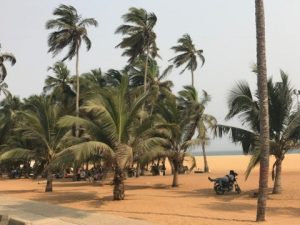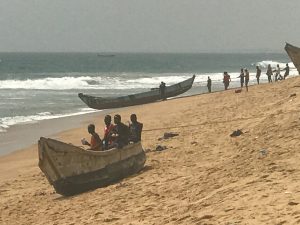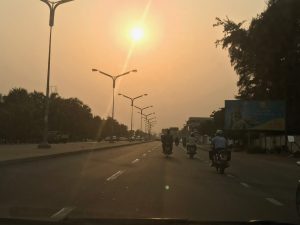Togo – Border to Border Beach Country
Togo is a Beach Country, Laid Back, and Pleasant
The beach starts and ends at the borders as well as goes inland
Most Meaningful Experience: Hanging out, relaxing, and just catching up on energy.
Travel Tips:
-
Soak up the nighttime atmosphere around the beach, which greets you as soon as you arrive in Togo.
-
Try the local gombo and couscous at one of the beachside restaurants near the border with Ghana
-
Get up close to African wildlife at the Fauna Cultura mini-zoo.
I found the contrast between Togo and Benin starkly apparent even at the border. On the Benin side, I’d been interrogated by an official asking why I was there and where I was going after Togo. But on arrival at the Togo border control, a guide had welcomed me with “hello” and escorted me to a building where three other officers were watching TV and chatting. When I explained that I didn’t have a visa, he said not to worry and that it would be 30,000CFA ($25), just as they had told me at the embassy in Lagos.
Six passport stamps later and I got my first glimpse of Togo, with the typical hustle and bustle that surrounds African borders. But unlike Seme at the Nigeria/Benin border, people here respected each other’s space and although I was approached by hawkers, nobody hassled me.
Around 100 meters from the border was the beach and this extends all the way to Ghana, only being interrupted by a large port on the outskirts of Lome. As we drove towards the capital city, I looked out across the white sands and azure waters of the Atlantic Ocean and felt immediately calm. Motorbikes, fishermen and beach bars scattered the palm-lined route, eventually giving way to the urban sprawl of Lome.
Unfortunately, Togo didn’t allow roaming on our Nigerian SIM, so Tayo went in search of a new card so we could find our Airbnb. As I waited beside our taxi, a guy approached to ask if I was okay and I was touched by his concern for my wellbeing.
Eventually, we made our way to the Airbnb, which to our dismay was around 10 kilometers inland from the beach. Our host Anglich didn’t speak any English and with a few communication issues, we ended up having to share a bed in a house that appeared like a mansion compared to those in the surrounds. It was a lively community though, with fruit stands, restaurants and convenient stores scattered through the streets, and plenty of comings and goings late into the night.
The following day we hired a local driver to tour the area, visiting the small Togo National Museum and a fetish shop that featured voodoo paraphernalia. After a blessing from the priest and the purchase of a travel safety ornament, we headed down to the beach for lunch. A highlight of Togo for me was Fauna cultura – a free mini-zoo where you can get up close to African wildlife, such as ostriches and crocodiles.
The following day we headed to the ABC transport station to buy a ticket to Ghana (16,000CFA) and had our final lunch in Togo at a nearby cafe that did to-die-for French cakes. Our departure was hassle-free, with an easy border crossing to finish what had been a memorable experience.
Although poorer than Benin, my impression was that Togo was self-sufficient, with lots of commercial activity. The sandy streets that radiate from Lome’s city center are a hive of activity, even in the evenings when people spilled onto the street to watch the African Cup soccer tournament. People seemed happier than in Benin and all of my interactions had been warm and friendly, with the Togolese more accommodating of tourists and willing to speak in English, no matter how limited it might be.

The Togo Beach










